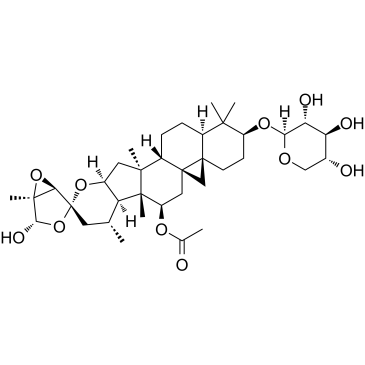Bioactivity-guided isolation of GABA(A) receptor modulating constituents from the rhizomes of Actaea racemosa.
Serhat S Cicek, Sophia Khom, Barbara Taferner, Steffen Hering, Hermann Stuppner
Index: J. Nat. Prod. 73(12) , 2024-8, (2010)
Full Text: HTML
Abstract
Black cohosh (Actaea racemosa) is a frequently used herbal remedy for the treatment of mild climacteric symptoms. In the present study, the modulation of γ-aminobutryic acid (GABA)-induced chloride currents (I(GABA)) through GABA type A (GABA(A)) receptors by black cohosh extracts and isolated compounds was investigated. GABA(A) receptors, consisting of α(1), β(2), and γ(2S) subunits, were expressed in Xenopus laevis oocytes, and potentiation of I(GABA) was measured using the two-microelectrode voltage clamp technique. In a bioactivity-guided isolation procedure the positive modulation of I(GABA) could be restricted to the plant terpenoid fractions, resulting in the isolation of 11 cycloartane glycosides, of which four significantly (p < 0.05) enhanced I(GABA). The most efficient effect was observed for 23-O-acetylshengmanol 3-O-β-d-xylopyranoside (4, 100 μM), enhancing I(GABA) by 1692 ± 201%, while actein (1), cimigenol 3-O-β-d-xylopyranoside (6), and 25-O-acetylcimigenol 3-O-α-l-arabinopyranoside (8) were significantly less active. In the absence of GABA, only 4 induced small (not exceeding 1% of I(GABA-max)) chloride inward currents through GABA(A) receptors. It is hypothesized that the established positive allosteric modulation of GABA(A) receptors may contribute to beneficial effects of black cohosh extracts in the treatment of climacteric symptoms.
Related Compounds
| Structure | Name/CAS No. | Molecular Formula | Articles |
|---|---|---|---|
 |
Actein
CAS:18642-44-9 |
C37H56O11 |
|
Growth inhibitory activity of extracts and compounds from Ci...
2008-06-01 [Phytomedicine 15(6-7) , 504-11, (2008)] |
|
Studies on the Chinese crude drug "shoma." IX. Three novel c...
1995-05-01 [Chem. Pharm. Bull. 43(5) , 771-6, (1995)] |
|
Actein and a fraction of black cohosh potentiate antiprolife...
2006-10-01 [Planta Med. 72(13) , 1200-6, (2006)] |
|
Pregnane X receptor-mediated induction of Cyp3a by black coh...
2011-02-01 [Xenobiotica 41(2) , 112-23, (2011)] |
|
Anti-AIDS agents. Part 57: Actein, an anti-HIV principle fro...
2004-03-08 [Bioorg. Med. Chem. Lett. 14(5) , 1329-32, (2004)] |